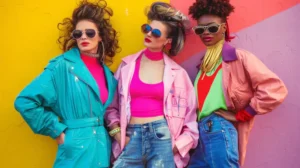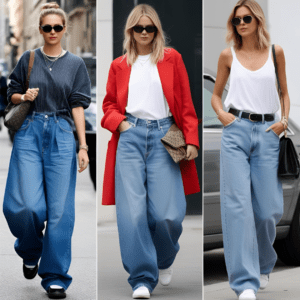The Bold and Brilliant Era of 80s Fashion
The 80s fashion was ten years that erupted with striking shades, big silhouettes, and unapologetic self-expression. It absolutely was a period when style wasn’t nearly seeking good—it had been about building a statement. From power fits and leg warmers to neck patches and neon, 80s style reflected the social, political, and technical adjustments of the time. Music videos, television, and place culture celebrities played substantial functions in shaping what folks wore, and the effect of 80s style can still be observed today in modern variations and trends.
Power Dressing and Rise of Working Woman in 80s fashion
One of the very most defining facets of 80s fashion was the idea of power dressing, specially for women. As more girls joined the workforce and climbed corporate ladders, their style reflected desire, confidence, and authority. This period marked the increase of the power match—a look indicated by vast neck patches, organized blazers, and pad dresses or trousers. Developers like Giorgio Armani and Donna Karan pioneered these designed seems that healthy masculinity with femininity.
The increased exposure of solid shoulders symbolized power and dominance, a nod to the moving gender character of the time. Women were asserting their presence in qualified spots, and their apparel offered as shield in boardrooms.
Street Style and Youth Rebellion of 80s fashion
While professionals embraced smooth silhouettes, the streets informed a different story—certainly one of individualism and rebellion.Downtown childhood inspired by hip-hop, punk, and new trend music adopted variations that have been anti-establishment and expressive. Brands like Adidas, Puma, and Kangol turned basics in the hip-hop neighborhood, with tracksuits, container hats, and big silver jewelry creating a identifiable aesthetic.
Punk style, popularized by artists like The Intercourse Guns and Vivienne Westwood, favored ripped apparel, safety pins, leather coats, and heavy boots. Meanwhile, the brand new trend scene brought in decorative patterns, artificial materials, and fresh hairstyles. Each subculture had its distinctive style, and apparel turned a language for childhood expressing personality and resistance.
The Influence of Pop Icons

80s style was largely designed by place culture and media.With the increase of MTV in 1981, music videos turned just as crucial because the music itself, providing an aesthetic party that inspired international style trends. Madonna, as an example, turned a manner symbol with her split lace, crucifix jewelry, fingerless gloves, and “lingerie as outerwear” approach. Her design forced boundaries and redefined what it designed to become a woman place star.
Michael Garcia was yet another enormous effect, with his military-style coats, sequined gloves, and fedora hats getting style staples. His red leather coat from the Thriller video stays one of the very most well-known bits of the decade.
On television, shows like Dynasty and Miami Vice displayed opulent lifestyles and sharp-dressed heroes, more reinforcing the decade’s preoccupation with luxury, excess, and image.
Athletic and Aerobic Aesthetics
The 80s also gave increase to the exercise trend, thanks in big portion to results like Linda Fonda and Richard Simmons.Exercise videos turned wildly popular, and so did aerobic style.This included spandex stockings, leotards, headbands, and leg warmers—frequently in brilliant neon shades and striking patterns. Running wear transitioned from the gymnasium to the road, blurring the lines between everyday and activewear.
This period planted the vegetables for what can later evolve in to athleisure, a style that stays dominant today. Brands like Reebok and Nike capitalized on the tendency, introducing sneakers and apparel that merged function with fashion.
Men’s Fashion: Flash, Funk, and Flair
Men in the 80s fashion weren’t scared to test out style. Affected by rock stars, players, and Hollywood, guys embraced everything from pastel fits to acid-wash jeans. Customers Only coats, visual tops, mullet hairstyles, and Ray-Ban sunglasses were all part of the guy style arsenal.
The Miami Vice look—linen fits with T-shirts and loafers—turned a signature style. Androgynous style also acquired grip with artists like King and David Bowie, who played with gender norms through their bold, frequently flamboyant apparel choices.
Materials and Colors
The 80s was ten years of artificial materials—abs, cotton, Lycra, and spandex dominated the scene. These products permitted for more expand, glow, and imagination in design. Sequins, metallic finishes, and sparkling finishes were every-where, specially in evening wear and team fashion.
Color-wise, the 80s was a party of excess. Neon pink, electric blue, lime green, and brilliant orange were typically worn—occasionally all at once. Habits were also striking: believe animal images, geometric patterns, and visual designs. Fashion wasn’t about subtlety; it had been about being seen.
Accessories and Hair
Extras played an enormous position in defining 80s fashion. Big earrings, bangles, belts with big buckles, and clutch bags completed the look. Shades were crucial, frequently with shaded or mirrored lenses and heavy frames.
Hairstyles were just as extravagant. Huge hair was typical, reached through teasing, perms, and gallons of hairspray. Women sported voluminous curls or feathered variations, while guys gone for mullets, slicked-back variations, or high-top fades.
The Legacy of 1980s Fashion
While some 80s style developments might appear extravagant by today’s requirements, several have created significant comebacks. Neck patches, high-waisted jeans, plant covers, and large sneakers have all returned to conventional fashion. Modern makers often guide 80s aesthetics, mixing them with contemporary cuts and materials.
The era’s effect on streetwear, place culture, and gender-neutral style remains to shape how exactly we gown today. In a global where self-expression and uniqueness are celebrated a lot more than ever, the 80s serve as a reminder that style is not merely about clothing—it’s about attitude, culture, and identity.













Post Comment